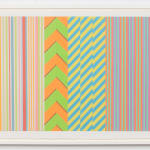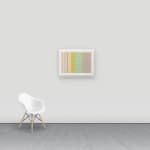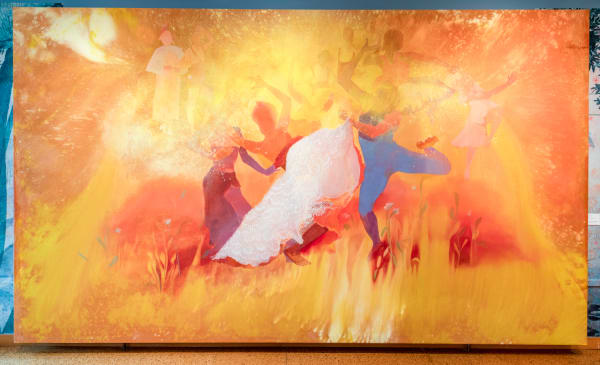James Little USA, b. 1952
Too Close to Call (study), 2015
Raw pigment on paper
22 x 30 in
55.9 x 76.2 cm
55.9 x 76.2 cm
8098
Further images
Too Close to Call (study), by 2022 Whitney Biennial artist James Little, depicts four pattern fields: the two on the opposite ends feature horizontal lines; in the middle left is...
Too Close to Call (study), by 2022 Whitney Biennial artist James Little, depicts four pattern fields: the two on the opposite ends feature horizontal lines; in the middle left is a stacked series of chevrons; on the middle right is a series of three columns of stacked, slanted lines. Despite the abstract nature of the composition, the title Little gives it, which relates to the fragility of human perceptual ability, offers some hint of the subject matter that was on his mind while painting it. This painting also offers a luminous glimpse into Little's detailed and time consuming process. Little is a methodical master, whose paintings frequently take as long as six months to finish as thick layers of handmade pigments are built up. The intensity and power of Little’s paintings can be credited to his devotion to experimentation with color relationships.
These vibrant studies on paper are the speculative fields where that spirit of intense experimentation plays out. The artist’s distinctive abstract aesthetic language, which is rooted in geometric shapes and patterns, flat surfaces, and emotive color relationships, is evident in these studies. As is his enduring interest in the complementary forces of simplicity and complexity.
Most painters paint with wet mediums that are made by mixing a dry pigment (think ground umber) with a wet binder (such as linseed oil). The pigment carries the color, while the binder suspends that color in a form that can be transferred onto a surface using a brush or other painting implement. There are some painters, however, who skip the binder and paint directly with the dry pigment. You can simply apply the dry pigment to a surface then coat it with some kind of clear sealer.
Raw pigment gives the painter more control over aesthetic issues. Raw pigments create a much more translucent layer than wet paint, which can be helpful for painters experimenting with underpainting effects and painters who are looking for different ways for their colors to react with light, and with each other. Raw pigments also create a texture that is much more earthy and organic looking than the smooth surface created by wet paint.
As a painter who wants as much control as possible over his materials and paintings, James Little is famous for hand making his own mediums. One way he achieves this is to paint with dry pigments; another way is to manufacture his own encaustics, by suspending his pigments in a melted wax binder.
These vibrant studies on paper are the speculative fields where that spirit of intense experimentation plays out. The artist’s distinctive abstract aesthetic language, which is rooted in geometric shapes and patterns, flat surfaces, and emotive color relationships, is evident in these studies. As is his enduring interest in the complementary forces of simplicity and complexity.
Most painters paint with wet mediums that are made by mixing a dry pigment (think ground umber) with a wet binder (such as linseed oil). The pigment carries the color, while the binder suspends that color in a form that can be transferred onto a surface using a brush or other painting implement. There are some painters, however, who skip the binder and paint directly with the dry pigment. You can simply apply the dry pigment to a surface then coat it with some kind of clear sealer.
Raw pigment gives the painter more control over aesthetic issues. Raw pigments create a much more translucent layer than wet paint, which can be helpful for painters experimenting with underpainting effects and painters who are looking for different ways for their colors to react with light, and with each other. Raw pigments also create a texture that is much more earthy and organic looking than the smooth surface created by wet paint.
As a painter who wants as much control as possible over his materials and paintings, James Little is famous for hand making his own mediums. One way he achieves this is to paint with dry pigments; another way is to manufacture his own encaustics, by suspending his pigments in a melted wax binder.
Exhibitions
James Little: Homecoming 2022. The Dixon Gallery and Gardens, Memphis, TN, USA
Share
- X
- Tumblr
1
of
41










